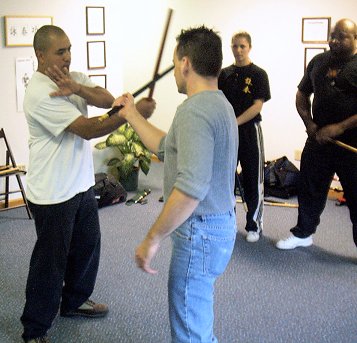its paid sponsors, whose products you need!
| Home |
| Intro |
| Current Issue |
|
Mailing List |
| Store |
| Strength |
| Subscriber Content |
| ARCHIVES
|
| Martialism |
| Pacifism |
| Q & A |
| Cunning-Hammery |
| Advertise With Us |
| Submit An Article |
| Staff |
| Discussion Forum |
| Links |
“Stay ‘unreasonable.’ If you
don’t like the solutions [available to you], come up with your
own.”
Dan Webre
The Martialist does not
constitute legal advice. It is for ENTERTAINMENT
PURPOSES ONLY.
Copyright © 2003-2004 Phil Elmore, all rights
reserved.
First Look: Kali Class Observation
By The Martialist Staff
 On
On
a rainy May day in Syracuse, Sifu Eric Winfree and his students gathered at
the Syracuse Wing
Chun Academy for their regular training. Sifu Anthony Iglesias of
SWCA feels strongly about building relationships with his fellow martial
artists and regularly makes his facilities available to local schools.
Sifu Winfree teaches multiple styles, including Jun Fan Jeet
Kune Do, JKD Groundfighting, and Chinna Kali. The class he held at SWCA
focused on training with sticks and blades. “We train the stick to
learn the knife,” he explained.
A large portion of the class was devoted to training with
single and double sticks. Students worked in pairs and drilled specific
patterns, switching from one to another at Sifu Winfree’s instructions.


As in any class, some of the students were more experienced
and thus more advanced than others. Sifu Winfree and his senior students
made every effort to encourage them and help them learn.




Sifu Winfree also paused more than once to speak about the
philosophy behind the training. There is only one way to tell the truth,
he explained to his students. That same truth is found in Wing Chun, in
Jeet Kune Do, and in Kali. What works, after all, is what works.

At one point, Sifu Winfree encouraged the students to have
faith in what they were learning — to trust the art. Practice may make
something permanent, but — as Sifu Winfree pointed out — it is belief
that makes one’s practice real.

